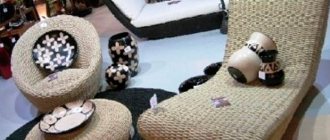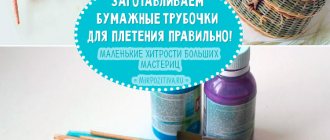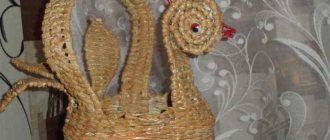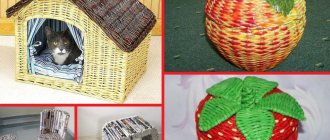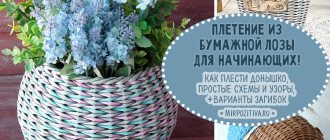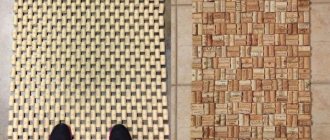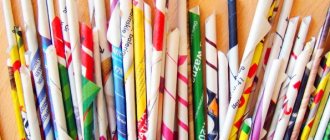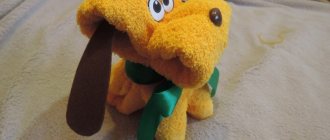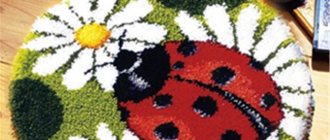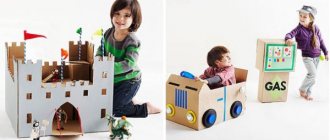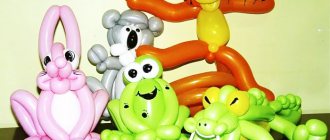Before you start weaving a square box, you need to learn how to make a square bottom. Let us immediately warn you that the square shape often causes difficulties for beginners, so beginners are recommended to start with small round baskets. You can familiarize yourself with the procedure for weaving such baskets in our previous article “How to weave baskets from newspaper tubes.”
There are several ways to make a square bottom:
- Use ordinary plywood (we will tell you more about it below);
- Weave the bottom using tubes, the bottom will turn out beautiful, wicker. But this option will be a little difficult for beginners at the initial stage;
- The bottom for a wicker box can be a piece of corrugated cardboard covered with paper, wallpaper or fabric.
Let's first look at this option for making the bottom.
History of the craft
Weaving from plant stems was used already in Neolithic times. Archaeologists have found household items made in this way both in Africa and throughout Eurasia. It is assumed that people used thin tree roots and flexible vines for weaving.
Much later, the interlacing of long rods began to be used in construction. In the nineteenth century, many roofs were made using this technology. Ordinary people made fences near their houses, the rich could boast of wicker furniture.
Today, decorative wicker souvenirs can often be found at folk craft exhibitions. However, you don't have to stop at history alone. Using the weaving technique using newspaper tubes, real designer objects are created.
Round box with lid
Cut out two circles from thick cardboard, coat them with glue and cover them with newspaper or any other beautiful paper. To carefully wrap the edges in a circle, make cuts along them. If you wish, you can immediately paint and dry the workpieces well.
Popular articles Smeshariki from doughUsing double-sided tape along the entire diameter, place stand tubes, the number of which must be calculated in advance. Fill everything with glue around the perimeter, place the second bottom piece on top and dry it under pressure. To start weaving, insert a working tube next to the stand or connect two and loop it on.
Braid the entire base around the perimeter with two tubes of a spikelet, pressing tightly. Moisten it a little, bend the racks, and lift them up on the next lap. To make the box more interesting, add a second working tube of a different color.
Build up all the details so that these places are hidden on the wrong side. And so that when weaving the box itself holds its shape, use a blank of a suitable size. You can braid any round box of the same diameter. Weave the last row, bending the racks inwards as much as possible parallel to the bottom.
Then carefully bend each post one after the other and cut it to the same length. Lift them back and braid them again with two long working tubes, just like the sides before. After three rows, cut all the posts as close to the edge as possible and tint the ends.
Make a beautiful decorative cover from cardboard, wrapping paper or napkins. Glue the posts into it in the same way as into the bottom, and use the same principle to weave a small lid. Calculate the number of rows during the process, based on your box.
Preparation of tubes
Before you start weaving, you need to prepare the starting material - wind tubes from newspapers or magazines. You will need the paper itself, PVA glue in a bottle with a dispenser, a long pushing knitting needle or a piece of stiff wire. The diameter of the knitting needle/wire is 1.5-2 mm. These are all tools at the preparatory stage.
Lots of ideas - lots of material
To prepare the tubes, you must first cut the paper into pieces of the desired size. We cut newspaper strips or magazine spreads into several parts. Aspect ratio - 1:3 or 1:4 (for example, 27 * 9 cm, 35 * 10 cm). The exact dimensions are not important. Divide the page into several parts so that they are approximately the same aspect ratio as above.
Take a knitting needle and a strip of paper. We twist the corner of the paper around the knitting needle, and gradually, layer by layer, roll it into a tube. Secure the edge of the strip with a drop of glue. To make the tube the desired density, we lay the paper at 45° relative to the knitting needle. Then it will be quite dense, but at the same time it will bend well.
This is how we make paper tubes for weaving
We take out the knitting needle. The tube is not too long; to work, you will have to splice them together. If everything is done correctly, one edge will be thin, the other will be thick and hollow from the inside. To connect two newspaper tubes, drop a few drops of PVA glue into the thick part and insert the second tube with a thin edge. Now we wait until it dries.
Sometimes, for simpler weaving, the tubes are rolled using a regular rolling pin. They become flatter. In this form it is easier to work with them - stretch them between the rows. But this is an optional step. Try “rolling”, maybe you will like weaving from newspaper tubes more this way.
Not everyone likes the “natural look” of newsprint weave. To improve the appearance, the wound tubes are painted. Acrylic paint is best suited for this. It fits tightly, works well with any type of paper, does not flow, dries quickly and has no odor. A water-based, moisture-resistant stain will also work. Paper tubes coated with acrylic varnish, to which a coloring pigment is immediately added, look good. Simultaneously with painting, they become less sensitive to moisture.
Some colors of water stain for dyeing paper straws
Painting each tube with a brush is long and tedious, so they look for a long tray into which the tubes are placed. Paint is poured into it, and ready-made newspaper tubes are lowered into it. Then they are laid out on a layer of polyethylene to dry.
Before starting weaving, so that the “newspaper vine” bends well, you can moisten it. It is better and easier to do this from a spray bottle, simply spraying water.
Master class No. 4
You will need:
- box (either a regular cardboard box or a cigar box will do);
- corduroy or velvet fabric;
- foam rubber 1.25 cm thick (the width should be equal to the width of the foam rubber pad, and the length should be twice its length (for example, if the finished pad measures 12.5 x 12.5 cm, then you will need a piece of foam rubber measuring 12.5 x 25.5 cm));
- thin cardboard (you can, for example, use a notebook cover);
- stationery knife;
- scissors;
- ruler;
- hot glue gun.
From thin cardboard, cut a rectangle 3 mm smaller than the bottom of the box. Use a pencil to mark where the foam pad will end and cut the cardboard at that point. Take the base cardboard for the soft pad and line it (the width of the strips should be approximately 2.5 cm).
Next, take a piece of foam rubber the width of a cardboard, but twice as long as it, line it into strips 5 cm wide, then cut along the lines. Apply glue to one section of cardboard and glue the foam rubber, after folding the piece in half lengthwise. Glue the remaining pieces of foam rubber in the same way.
Take a piece of fabric equal in width to the resulting base, but much longer than it. Glue one end of the piece to the back of the cardboard, wrap and cover the foam pads, inserting the fabric into the gaps between them. Use the remaining fabric to wrap the cardboard again and glue.
Now you will need a piece of cardboard 1 cm wider than the height of the resulting pad. Bend it, stepping back 1 cm from the edge (the bent cardboard should “cover” the foam rubber). Make a “wall” for the other side of the pad in the same way.
Take two pieces of fabric (they should be 2.5 cm larger than the cardboard itself), cut off the corners and cover the cardboard. Glue the “walls” on the sides of the pad.
Cover the cardboard that you are going to glue to the remaining area of the bottom of the box with fabric. Glue both pieces to the bottom of the box and you're done!
Photo ideas for weaving tubes
Beginning craftsmen master weaving from newspaper tubes using simple crafts. As you gain experience, you want to diversify your products and use more complex patterns. In some cases, interesting-looking weaving is not necessarily complex. Such an example is in the following photo gallery. It contains step-by-step photos of creating chess weaving.
As you can see, the weaving is simple, and this product looks interesting. There are also other methods. If you look closely at the photographs, there is a chance that you yourself can repeat or do something similar.
A simple basket. This is a great option to learn how to weave from newspaper tubes
One of the options for finishing the job
Several ways to bend racks Using a variety of patterns makes baskets of the same size unrecognizable
But you can’t tell that it’s made of paper. You can weave a basket for a cat from newspapers. She will feel comfortable in such a bed
Openwork weaving from tubes - it is important to maintain equal distances
Laundry basket
You can also use pebbles/beads as decoration.
Some are woven with ordinary rope, some are woven using layer-by-layer weaving. A series of identical baskets made of paper tubes are functional and beautiful
Surprisingly, but true - you can even weave furniture from newspaper tubes! And not only a puppet, but also a real one!
Photo frame
Crafts from newspaper tubes or a master class from them allow you to make not only various kinds of animals, but also something useful for your home, for example, a photo frame. For it you will need a dense rectangular base on which you need to glue a sheet of newsprint. When everything is dry, take the blanks and apply glue along the edge to form the sides.
Start placing newspaper tubes in each corner at a forty-five degree angle. Their number will depend on the size of the photograph or painting that you place in the frame.
When you're done with the corners, start forming the inner sides. Glue only the corners, leaving the sides free to pass through. The frame can also be decorated with various patterns to suit your taste.
Necessary materials and tools for weaving
Everyone himself determines by experience which paper is easier for him to twist the tubes with. Magazines, notebooks, newspapers, sheets of writing paper, advertising brochures, cash register tape and any other tape that you can roll up, even edible tracing paper, will do. You will also need a glue stick, PVA, scissors and knitting needles.
To twist snow-white unpainted fragments, you should pay attention to the percentage of whiteness. The smaller it is, the grayer the wickerwork and vases will be and additional coloring will be required. The thicker the paper, the more difficult it is to twist and weave.
When cutting paper, consider the direction of the grain. To do this, take a sheet and try to tear off a strip lengthwise first. If the edges turn out to be a zigzag, and the tear always tries to move to the side, then the process occurs across the fibers. With this cutting, the paper will not curl, and the tubes will turn out “shaggy”.
The use of homemade boxes
A box in the house for a woman is a very useful thing, and for a needlewoman it is simply necessary. Moreover, the more of them, the better: in one there are embroidery threads, in the second - balls, in the third - knitting needles, hooks and needles, in the next - ribbons and braid. And somewhere else you need to put scissors, glue, a stationery knife, stencil staplers... The more hobbies you have, the more boxes, chests and boxes you need.
Small boxes are suitable for small items, and a large box can be intended for laundry prepared for washing.
In addition to the fact that the box is a necessary thing in the house, it is also a wonderful gift: as an independent gift or as a box for the main gift. A wide variety of design options will make it, depending on the occasion, spectacular and original, festive and discreet.
Types of weaving
When making products, the paper vine is extended by inserting one tube into another. The fact is that during the twisting process, one end turns out to be thicker than the opposite, and it is not difficult to connect them. You can use a drop of glue, but many people do without it. If the tip is too soft, you can trim it slightly to make the connection easier.
There are several types of weaving baskets from newspaper tubes, and they are similar to weaving from natural wicker:
- Simple weaving;
- Rope weaving;
- Plain weave;
- Diagonal weaving;
- Spiral weaving.
It is recommended to start with wicker weaving with the simplest and most versatile rope weaving. It is more durable than simple weaving and looks more beautiful. In addition to using different techniques for this type of needlework, you can create patterns by skipping rows or creating holes in the work. Using different colors of tubes and alternating them, you can create your own unique patterns and combinations.
Type of weaving from newspaper wicker "rope"
Decorating the edge of a wicker product
In order for the wicker product to look aesthetically pleasing, it is important to beautifully decorate the edge by securing the tubes.
One of the working ways to remove the edges of the tubes is to weave them into the edge of the product. The ends of the blanks are bent and passed into the weaving of the wall. This is easy to do using a knitting needle, carefully tucking the protruding parts into the braided pattern.
The excess is cut off. You can secure the ends of the tubes in a braided pattern using glue. You can decorate the edge beautifully with the help of additional weaving. The racks are alternately bent and braided behind each other.
The work is performed sequentially, braiding three tubes in turn. The edges are hidden in the wall, carefully trimmed with scissors and fixed with glue. To decorate the edge, you can weave an additional tube into the pattern, securing the edge with the final row.
Features of paper curling
Only at first glance, “twisting” is performed quickly and easily. Practice shows that you can master the technique taking into account several features.
- We cut strips of the same size from the press spreads in an approximate ratio of 1X3. To increase productivity, fold the paper into a stack and use a utility knife;
- hold the tool at an angle of 45° and tightly wind the tapes onto it. If you wind the paper at an angle of 30°, you will get a thick stick (it will be useful for “knitting needles”). And at 90° the stick will turn out to be very thin (it is used for edging);
- We fix the tail-kerchief with glue, and then remove the workpiece.
During the twisting process, they are spliced together by inserting the thin end coated with glue from one tube into the wide hollow hole of the other.
For panels, decorative rugs and frames, flat blanks are required.
Place the finished “twigs” on a flat, hard surface and roll them with a rolling pin. Look at the master class in the photo.
What stages will you have to go through?
Step one. Fold the newspaper in half and cut it in half. Wrap one finished piece of newspaper in wire or knitting needle.
Step two. Glue the entire remaining edge of the newspaper and roll it up to the very end. To make a box you will need approximately 30 of these sticks.
Weaving from newspaper tubes for beginners step by step: photo instructions with examples of work
Making one box at a time
1 4
Any box with edges of the same height is taken as a basis. We turn it upside down and attach it to the bottom of the tube with superglue at a distance of 4-5 cm, creating something like stands. We turn the bottom down and direct the tube stands upward.
Using simple weaving, we make the first row, then the next, then glue a new tube to the bottom, threading it over and under the vertical ones, alternating the sequence. We continue the process until the walls of twists reach the edge of the base box. We fix the ends with glue, cut off the excess, and tuck the tails inward with a knitting needle.
What can you weave from newspaper tubes?
Wicker decor is increasingly found in interiors. It could be something small, like a photo frame. Such a modest element can be used in almost any interior style (with the exception of high-tech style).
Items made from newspapers look especially good in a country house. A unique village atmosphere is created. Various vases, boxes, and chests would be appropriate here. It should be noted that all these items can be used on the farm. The result of weaving is a very durable product.
In a modern apartment there is also a place for such things. In the nursery you can use baskets for toys. Laundry baskets are ideal for the bathroom. By the way, coated with varnish they are not afraid of moisture.
Sometimes you can even find accessories made using this technique. For example, an elegant wicker clutch will be a great addition to your look.
Weaving from newspapers is a great way to simultaneously get rid of accumulated waste paper and create a unique design object. The result is a beautiful and durable thing that can be used in life. Homemade interior items fill the room with comfort and warmth. In addition, all hand-made products are unique and original. There is a guarantee that no one else will have exactly the same box.
Newspaper flower
Anyone who has learned how to twist tubes can make a flower. A fairly simple craft that can be used both as a decoration and as a hot plate.
What you will need to produce the product: pre-prepared tubes, scissors, PVA glue and decorative composition for finishing.
Step 1. Making the base.
You should take 6 tubes - two bases for the product, 3 pieces each (let's call them base A and base B). Their middle needs to be kneaded a little (it should become flatter). After this, the remaining three tubes (B) are attached perpendicularly to three blanks (A) tightly laid together with glue.
Core formation scheme
You need very little glue, otherwise this area will be difficult to paint over later. After this, you will have to wait a little while the structure sets. You can begin to braid the resulting cross-shaped base.
Making the base
Step 2: Forming the core.
A long piece is prepared from two tubes using extensions. To do this, one of the ends of the part must be cut at an acute angle, after which, pre-lubricated with glue and slightly compressed, it is inserted into the second tube. The resulting elongated part must be folded (not at the joint) and placed behind base B parallel to base A.
When weaving, you can periodically spray the material with a spray bottle. At the same time, the tubes become more pliable.
The lower part of the working tube is brought up onto base A (parallel and as close as possible to base B). The second working part, located at the top, is inserted downwards, under base A. To do this, the three tubes that make it up need to be lifted. The operation is repeated - the lower working tube moves upward, to base B, the second part, the upper one, is at the top. At the bend, you need to crumple the tube a little. The weaving should be tight. This forms the first row of the core.
Core formation
The second row is laid in the same way, only the tubes are placed next to the previous weave.
Step 3. Weaving a circle.
After forming the second row, you need to divide the component parts of the bases into two parts (one will have two tubes, the second will have one). The working tube lying on top is inserted under the first part of the divided base (of two elements) and ends up on top of the single part, the lower one braids the double base tubes from above, after which it covers the remaining base tube from below and is brought up. After this, weaving continues around the next divided warp, alternating between upper and lower grips.
Weaving a circle
The working tube needs to be extended periodically. In this way two rows are woven. After this, the double parts of the bases are separated. Now each of the base tubes is braided on both sides with working elements.
When the diameter of the product suits the performer, it is necessary to secure the working ends of the tubes by pulling them under the row of weaving (for this you can use scissors or a knitting needle and slightly move the dense structure apart) and trim them (you can apply a drop of glue for fixation).
The result was a neat wicker circle, looking equally beautiful both from the front side and from the back, with tubes of bases sticking out along the perimeter.
Growing the Circle
Step 4. Formation of petals.
The tubes of the bases are kneaded to a state of pliability. After this, they are bent and passed through two rows of weaving. The size of the petals can be any size the master likes. The ends of the tubes are cut off. The petals are pulled up a little so that the cut ends are not visible. You can also apply a little glue.
Formation of petals
The resulting piece can be painted with water-based stain or acrylic paint.
Such a detailed description of the manufacture of such a simple product is due to the fact that its production technology can also be used for weaving more complex crafts.
Basket of straws
Before starting work, you need to decide on the size of the product and prepare the material. Unlike the flower, the making of which was described above, longer tubes will be needed for the base. And you need more of them - 6 pieces for each base.
The base is made in a familiar way. The difference is that the division of the base occurs in 2 stages: first into double tubes and then, when the diameter of the base reaches approximately 10 - 12 cm, into single elements. After the bottom reaches the required size, weaving stops. It is advisable to have some form at hand, the diameter of the bottom of which would coincide with the manufactured base.
Round bottom weaving
- You will need two working tubes. They need to be secured to the base by placing them behind two rows of weaving near adjacent base elements.
- The pillars of the basket will be the base tubes sticking out around the perimeter. To prevent them from breaking at the bend, they need to be stretched a little.
- A selected container is installed on the base.
- The racks are raised vertically and braided with working tubes in the same way as was used to make the bottom. Periodically the latter are increased.
- During the process of forming the basket, a violation of the position of the racks may occur.
It is necessary to monitor this and align them (the distances between them should be approximately the same). First row - When the height of the walls reaches the required level, the container is removed from the basket.
Continuation of weaving - The remaining working tubes must be stretched to give them flexibility. Their ends are camouflaged in wicker rows.
- It is necessary to bend the racks.
To do this, they (softened) are hidden between the adjacent post and the weaving. To facilitate the process, it is recommended to use a knitting needle. From above, in the places where the racks were installed, for strength it is better to drip PVA glue. After it dries, you can trim off the protruding ends of the posts. Bending
It's time to move on to painting the finished structure.
A water-based stain is used for coloring.
Using a brush, the composition is applied to the wicker product. After painting, the basket must dry.
Painting with a brush
The basket must dry
To make the product stronger and last longer, it is recommended to varnish it.
Varnish
It is applied in a circular motion. It is better to remove clots of varnish that may form between the rows of weaving in a timely manner, otherwise they will worsen the appearance of the structure.
Applying varnish
After the basket has dried, a second layer of coating is applied. The container for storing small items is ready.
Basket after varnishing
Decorating a basket with fabric and lace
Having mastered the intricacies of weaving, you can move on to making more complex designs and decorations: decorative boxes, animal figurines, jewelry, photo frames, etc. If desired, you can even make a newspaper rack, shelves for books or spices from newspaper tubes.
Kitchen organizer
Kitchen set in Provence style
Coasters for wine and champagne
Rack for salt, pepper and napkins
Many people paint not the finished product, but the prepared tubes. But in any case, when decorating with water stain, you can often observe uneven coverage. Why this liquid may not stain tube crafts well:
- the most common problem is that the composition has expired or it has been sitting in the store for a long time, resulting in separation of the components;
- the stain may not paint over those areas where PVA glue has appeared;
- Glossy paper is difficult to paint, since water-based stains have difficulty penetrating its structure.
Water based stain
Varnish is used to finish finished products. But often wicker structures are used to store food products in them. The issue of security in this case is very important. It is recommended to use only water-based formulations, and with information on the label confirming their environmental safety. There are also varnishes designed for treating children's toys. In any case, it doesn’t hurt to put a paper napkin in the basket where candies and cookies will be stored.
To make interesting designer products with your own hands, you need a little: be patient, collect a stack of newspapers and use your imagination. And the result of the effort and time spent will delight the household for a long time.
You can create real masterpieces from newspapers
Box with cardboard bottom
Rectangular basket
The easiest way for beginners to master crafts from newspaper tubes is to weave a rectangular basket. Its shape allows you to familiarize yourself with the basics of technology and not get confused in complex maneuvers.
Summer hat
In a similar way, you can make your own summer hat for yourself or your loved ones. The technique is exactly the same as above.
Round basket with handle
Weaving from newspaper tubes, namely crafts from them, can turn out better if you use a frame. Such a frame can be a round plate on which the bottom or the entire work will be formed.
Take eight guide posts and connect them together, intertwining them with each other. They should form a square and face perpendicular directions. Next, take two tubes and insert them into the resulting base and begin to weave in a circle, forming the bottom and moving down.
The handle is made of woven paper vine, on which several tubes are wound.
Beautiful examples
Wickerwork not only decorates the interior, but also performs practical functions. Large baskets and boxes store laundry. Small ones can be used to store spices. The book box is a convenient place to store documents or jewelry.
The quality and beauty of the craft depends on the experience and skills of the craftswoman. Large wicker baskets are great for storing balls of yarn. Wicker boxes with an additional element inside are suitable for storing sewing accessories. This is a flat piece with sticks on which spools of thread are threaded.
Wickerwork in the form of original souvenirs of various shapes is good. For skilled hands it will not be difficult to weave a box in the shape of an apple, melon, or mushroom.
Heart-shaped boxes are popular. The bottom for this box is cut out in the shape of a heart from hard cardboard or plywood. Additionally, they make a decoration for it to cover the ends of the glued posts. Weave with any pattern upwards, maximally observing the shape of the heart. The lid for this box is made similarly to the bottom. Braid the workpiece in one of the ways. It is advisable to decorate a heart-shaped box with flowers, ribbons, beads and much more, which is up to the imagination of the craftswoman.
How to weave a box with your own hands, watch the video.
Machine for weaving from newspaper tubes
Products are not always woven around some kind of base. It happens that you have to act almost blindly. To work quickly and still get an even workpiece, some use a special device that is easy to make with your own hands. All you need is a wooden block and two flat strips of the same material. Here are the manufacturing steps:
- Secure a block about 3 cm thick in the middle of the planks using nails.
- Using a punch and hammer, mark the locations of future holes.
- Find a drill with a diameter slightly smaller than the wide part of the tubes, and drill holes at the required distance from each other. It is 2 cm.
- You can insert newspaper tubes into them and start working.
Let's get started
There are a number of techniques that you need to know, since each of them allows you to achieve a unique and inimitable result for your work. Considering these techniques in isolation from practice will not give you anything. Therefore, we suggest moving from simple products to more complex ones, learning the basics of weaving.
Useful tips from experienced needlewomen
1 3
In the process of work, unexpected moments and ordinary nuances may arise that are understandable to professionals, but cause confusion and difficulties for beginners. Experienced handmakers are happy to share recommendations.
Best answers
Maria Klimova:
I remember in the early 90s there were problems with cigarettes and tobacco, our men smoked tea and brooms :) True, true. They made tubes out of newspaper (they wrapped pieces of newspaper around a pencil, then removed them from the pencil to form a neat tube), filled them with tea and smoked. And the brooms were like this: they broke off the stem from the handle of the broom, set it on fire and smoked it like a cigarette. I don’t know how it feels, I haven’t tried it.
1 `:
I remember I made it out of toilet paper, it turned out great, ... it smells like some kind of dope, you don’t get high, but your head sticks out in a special way... It's better to drink it.
}{PO”:
well, respect, smoking, well, probably like everyone else
Andrey Mikhailov:
Better not, you'll suffocate
Anastasia Morozova:
You can, but don’t take long puffs, otherwise your throat will be sore, it sticks out funny
Fruit basket
Finding practical uses for things you make yourself is always easy. For example, it would be a good idea to make a fruit basket: the product can be used instead of a metal fruit bowl and you can put light fruits inside. Some finished baskets can hold a lot of weight, everything will depend on the technique and density of the weaving.
Can store fruits
To make a beautiful fruit basket yourself, prepare 310 pieces of newspaper tubes - their length is 27 cm. It is recommended to pre-paint the tubes with the following composition: take 2 tbsp for half a liter of water. l. acrylic varnish and mix with the shade color. Process all the tubes and begin step-by-step work.
| Stage | Description |
| Bottom formation | The bottom is made using rope technique using a cross for the base. Take 12 tubes, divide them into groups of 3 each and glue the cross. |
| Weaving bottom | Weave 6 rows using this technique, braiding 3 tubes at once, and then begin braiding 1 bundle at a time. So you need to weave until you get a bottom of the desired diameter. |
| Forming the sides | To make rises for weaving the sides of the structure, you need to insert 3 more tubes into each hole with a stick. |
| Weaving of sides | By placing the bottom on a round object, such as a wooden bowl, you can continue working. Here you can already weave boards using the layer-by-layer technique: it is done in 2-4 rods and will be much more reliable than the rope method. |
| Creating openwork | To make the basket elegant, you can create a pattern: in the center of the weaving, simply cross the adjacent rods, imitating rhombuses. Press each connection with a clothespin and weave in new rods for further work. |
| Handle Formation | When the main work is ready, we begin to create a handle: we insert additional rods from the sides of the product and create a handle, according to the master class indicated above. |
| Decor | We finish the structure as we wish: we paint it with multi-colored pigments and make fabric inserts. |
Fruit basket
Detailed master class
This basket does not need a lid, because it is intended for storing fruit. The handle of the product can be effectively decorated with a rose made of foamiran.
How to decorate?
The simplest way to decorate a craft is with paint. This is done during manufacturing. But if for some reason the finished panel is not satisfied with its color, the composition can be enlivened with careless, multi-colored strokes. This will add brightness to the product and enliven the atmosphere. For painting it is recommended to use gouache or acrylic paints.
The newspaper panel is decorated using decoupage. This is a special technique using decoupage napkins or cards with a design. The image is transferred to any surface. But it is worth considering that for applying decoupage it is better to use a light composition from newspapers.
The finished composition is also decorated with various applications. The product can be decorated with beads, felt figures, sculpted parts, knitted elements, pine cones, dried flowers, leaves, coffee beans or bark.
